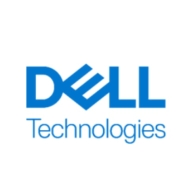

Find out what your peers are saying about Dell Technologies, Broadcom, Nutanix and others in HCI.
| Product | Market Share (%) |
|---|---|
| Dell PowerFlex | 9.3% |
| VxRail | 15.8% |
| VMware vSAN | 13.9% |
| Other | 61.0% |
| Product | Market Share (%) |
|---|---|
| FlexPod XCS | 10.3% |
| HPE ConvergedSystem | 16.6% |
| Oracle Private Cloud Appliance | 14.2% |
| Other | 58.9% |


| Company Size | Count |
|---|---|
| Small Business | 8 |
| Midsize Enterprise | 8 |
| Large Enterprise | 15 |
| Company Size | Count |
|---|---|
| Small Business | 34 |
| Midsize Enterprise | 66 |
| Large Enterprise | 182 |
Dell PowerFlex is a software-defined storage infrastructure delivering modern architecture and versatile deployment for on-premises or cloud. It achieves high performance, scalable storage, and workload consolidation through advanced automation.
PowerFlex's VMware compatibility ensures seamless integration, offering flexibility in compute and storage scaling. With its hyper-converged infrastructure, it caters to AI, cloud, and database environments, providing robust automation, resilience, and security. Flexible deployment options are complemented by a single-window management system, prioritizing cost optimization. However, enhancements are needed in monitoring tools, user interface, and AI functionality. Migration from Hyper-V and licensing flexibility also require attention, while improved documentation could simplify usage. Integration with services and streamlined upgrade processes are essential.
What are the key features of Dell PowerFlex?PowerFlex is essential in industries requiring support for mission-critical workloads and large-scale applications. It is instrumental for deploying storage, compute nodes, hyper-converged infrastructure, and private clouds. The platform integrates compute, storage, and networking, optimizing performance for modern applications like AI video analytics and disaster recovery.
FlexPod XCS is the secure platform your applications need from edge to cloud. Easily manage your suite of cloud-native, edge, and enterprise apps. Integrate advanced cloud services without compromising performance, security, reliability, or scale.
We monitor all HCI reviews to prevent fraudulent reviews and keep review quality high. We do not post reviews by company employees or direct competitors. We validate each review for authenticity via cross-reference with LinkedIn, and personal follow-up with the reviewer when necessary.